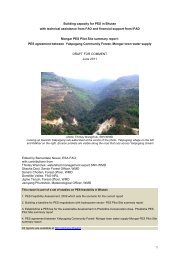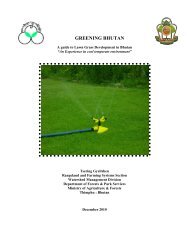Humanâwildlife conflict in the Kingdom of Bhutan: Patterns ... - DoFPS
Humanâwildlife conflict in the Kingdom of Bhutan: Patterns ... - DoFPS
Humanâwildlife conflict in the Kingdom of Bhutan: Patterns ... - DoFPS
You also want an ePaper? Increase the reach of your titles
YUMPU automatically turns print PDFs into web optimized ePapers that Google loves.
ARTICLE IN PRESS<br />
6 BIOLOGICAL CONSERVATION xxx (2008) xxx– xxx<br />
Cattle Horse Sheep Yak<br />
Dzongkhag<br />
Bumthang<br />
Chhukha<br />
Dagana<br />
Gasa<br />
Ha<br />
Lhuentse<br />
Monggar<br />
Paro<br />
Pemagatshel<br />
Punakha<br />
Samdrupjongkhar<br />
Samtse<br />
Sarpang<br />
Thimphu<br />
Trashigang<br />
Trongsa<br />
Tsirang<br />
Wangdue<br />
Trashiyangtse<br />
Zhemgang<br />
0 5 10 15 20<br />
0 1 2 3 4 5 6 7 8<br />
0 1 2 3 4 5 6 7 8 0 40 80 120<br />
Ratio <strong>of</strong> reported kills to relative abundance <strong>of</strong> livestock type<br />
Fig. 4 – The ratio <strong>of</strong> reported livestock kills to <strong>the</strong> relative abundance <strong>of</strong> livestock types with<strong>in</strong> each dzongkhag, accord<strong>in</strong>g to<br />
reports verified under <strong>the</strong> tiger compensation fund between 2004 and 2005, and livestock census data from RGoB (2000). For<br />
each livestock type, <strong>the</strong> vertical black l<strong>in</strong>e <strong>in</strong>dicates <strong>the</strong> average number <strong>of</strong> kills across <strong>the</strong> 20 dzongkhags that comprise <strong>the</strong><br />
K<strong>in</strong>gdom <strong>of</strong> <strong>Bhutan</strong>.<br />
Predation Prevalence<br />
(% <strong>of</strong> Total)<br />
Gasa<br />
(a) <strong>Bhutan</strong>, show<strong>in</strong>g 20<br />
Dzongkhags (districts)<br />
(d) Leopard<br />
>20%<br />
10-20%<br />
5-10%<br />
0-5%<br />
0%<br />
Ha<br />
Samtse<br />
Thimphu<br />
Paro<br />
Chhukha<br />
Punakha<br />
Dagana<br />
Wangdue<br />
Tsirang<br />
Bumthang<br />
Trongsa<br />
Sarpang<br />
Zhemgang<br />
Lhuentse<br />
Monggar<br />
Trashiyangtse<br />
Pemagatshel<br />
Trashigang<br />
Samdrupjongkhar<br />
(b) All Predators<br />
(e) Snow Leopard<br />
(c) Tiger<br />
(f) Bear<br />
Fig. 5 – The K<strong>in</strong>gdom <strong>of</strong> <strong>Bhutan</strong>, show<strong>in</strong>g (a) <strong>the</strong> 20 dzongkhags (districts); and livestock predation prevalence (kills per<br />
district as a percentage <strong>of</strong> <strong>the</strong> total number <strong>of</strong> kills) for (b) all predators comb<strong>in</strong>ed, (c) tigers; (d) leopards, (e) snow leopards,<br />
and (f) Himalayan black bears, between 2003 and 2005.<br />
Please cite this article <strong>in</strong> press as: Sangay, T., Vernes, K., Human–wildlife <strong>conflict</strong> <strong>in</strong> <strong>the</strong> K<strong>in</strong>gdom <strong>of</strong> <strong>Bhutan</strong>: <strong>Patterns</strong> ..., Biol.<br />
Conserv. (2008), doi:10.1016/j.biocon.2008.02.027





